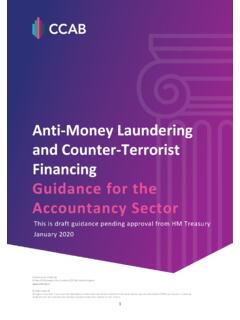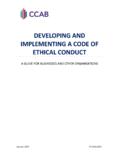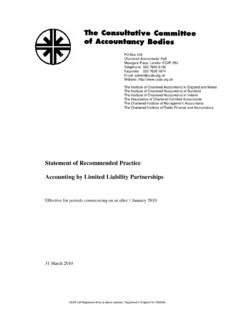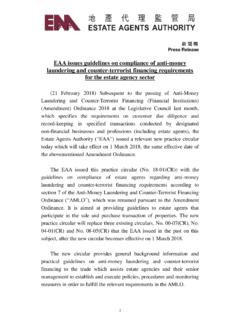Transcription of ANTI-MONEY LAUNDERING - ccab.org.uk
1 ANTI-MONEY LAUNDERING . GUIDANCE FOR THE. ACCOUNTANCY SECTOR. March 2018 CCAB Ltd 2018, All rights reserved ICAEWICAE. Introduction Accountants are key gatekeepers for the financial system, facilitating vital transactions that underpin the UK economy. As such, they have a significant role to play in ensuring their services are not used to further a criminal purpose. As professionals, accountants must act with integrity and uphold the law, and they must not engage in criminal activity. This guidance is based on the law and regulations as of 26 June 2017. It covers the prevention of money LAUNDERING and the countering of terrorist financing. It is intended to be read by anyone who provides audit, accountancy, tax advisory, insolvency, or trust and company services in the United Kingdom and has been approved and adopted by the UK accountancy AML supervisory bodies. The guidance has been prepared jointly by the CCAB bodies: Institute of Chartered Accountants in England and Wales Association of Chartered Certified Accountants Institute of Chartered Accountants of Scotland Chartered Accountants Ireland The Chartered Institute of Public Finance and Accountancy It has been approved and adopted by the UK accountancy supervisory bodies: Institute of Chartered Accountants in England and Wales Association of Accounting Technicians Association of Taxation Technicians Association of International Accountants Institute of Certified Bookkeepers Chartered Institute of Management Accountants Institute of Financial Accountants International Association of Bookkeepers Association of Chartered Certified Accountants Chartered Institute of Taxation Insolvency Practitioners Association Insolvency Service HM Revenue & Customs Institute of Chartered Accountants of Scotland Chartered Accountants Ireland - 2.
2 CONTENTS. 1 ABOUT THIS GUIDANCE 5. What is the purpose of this guidance? 5. Who is this guidance for? 6. What is the legal status of this guidance? 6. 2 money LAUNDERING DEFINED 8. What is money LAUNDERING ? 8. What is the legal and regulatory framework? 8. 3 RESPONSIBILITY & OVERSIGHT 10. What are the responsibilities of a business? 10. How should sole practitioners implement these requirements? 10. What are the responsibilities of Senior Management/ money LAUNDERING Reporting Officer? 10. How might the MLRO' role be split? 13. What policies, procedures and controls are required? 13. 4 RISK BASED APPROACH 17. What is the role of the risk based approach (RBA)? 17. What is the role of senior management? 17. How should a risk analysis be designed? 18. What is the risk profile of the business? 18. How should procedures take account of the RBA? 19. What is client risk? 20. What is service risk? 20. What is geographic risk? 20. What is sector risk? 21. is delivery channel risk?
3 21. is documentation important? 21. 5 CUSTOMER DUE DILIGENCE (CDD) 22. What is the purpose of CDD? 22. When should customer due diligence be carried out? 30. How should CDD be applied? 32. What happens if customer due diligence cannot be performed? 38. 6 SUSPICIOUS ACTIVITY REPORTING 40. What must be reported? 40. When and how should a report be made? 46. What is consent and why is it important? 51. What should happen after an onward report has been made? 53. 7 RECORD KEEPING 56. Why may existing document retention policies need to be changed? 56. What should be considered regarding retention policies? 56. What considerations apply to SARs and consent requests? 56. What considerations apply to training records? 56. Where should reporting records be located? 57. What do firms need to do regarding third-party arrangements? 57. What are the requirements regarding the deletion of personal data? 57. 3. 8 TRAINING AND AWARENESS 58. Who should be trained and who is responsible for it?
4 58. What should be included in the training? 58. When should training be completed? 59. 4. 1 ABOUT THIS GUIDANCE. What is the purpose of this guidance? Who is the guidance for? What is the legal status of this guidance? What is the purpose of this guidance? This guidance has been prepared to help accountants (including tax advisers and insolvency practitioners) comply with their obligations under UK legislation to prevent, recognise and report money LAUNDERING . Compliance with it will ensure compliance with the relevant legislation (including that related to counter terrorist financing) and professional requirements. The term must' is used throughout to indicate a mandatory legal or regulatory requirement. Businesses may seek an alternative interpretation of the UK ANTI-MONEY LAUNDERING and terrorist financing (AML) regime, but they must be able to justify their decision to their ANTI-MONEY LAUNDERING supervisory authority. Where the law or regulations require no specific course of action, should' is used to indicate good practice sufficient to satisfy statutory and regulatory requirements.
5 Businesses should consider their own particular circumstances when determining whether any such good practice' suggestions are indeed appropriate to them. Alternative practices can be used, but businesses must be able to explain their reasons to their ANTI-MONEY LAUNDERING supervisory authority, including why they consider them compliant with law and regulation. The UK ANTI-MONEY LAUNDERING regime applies only to defined services carried out by designated businesses. This guidance assumes that many businesses will find it easier to apply certain AML processes and procedures to all of their services, but this is a decision for the business itself. It can be unnecessarily costly to apply ANTI-MONEY LAUNDERING provisions to services that do not fall within the UK AML regime. This guidance refers, in turn, to guidance issued by bodies other than CCAB. When those bodies revise or replace their guidance, the references in this document should be assumed to refer to the latest versions.
6 Businesses may use AML guidance issued by other trade and professional bodies, including the Joint money LAUNDERING Steering Group (JMLSG), where that guidance is better aligned with the specific circumstances faced by the business. Where the business relies on alternative guidance, they must (in accordance with of this guidance) be in a position to justify this reliance to their ANTI-MONEY LAUNDERING supervisory authority. The law which comprises the UK AML regime is contained in the following legislation and relevant amending statutory instruments: The Proceeds of Crime Act 2002 (POCA) as amended by the Serious Organised Crime and Police Act 2005 (SOCPA);. The Terrorism Act 2000 (TA 2000) (as amended by the Anti-Terrorism Crime and Security Act 2001 (ATCSA) and the Terrorism Act 2006 (TA 2006));. The money LAUNDERING , Terrorist Financing and Transfer of Funds (Information on the Payer) Regulations 2017 (the 2017 Regulations);. Terrorist Asset-Freezing Act 2010.
7 5. Anti-terrorism, Crime and Security Act 2001;. Counter-terrorism Act 2008, Schedule 7;. The Criminal Finances Act 2017. POCA and TA 2000 contain the offences that can be committed by individuals or organisations. The 2017 Regulations set out the systems and controls that businesses are obliged to possess, as well as the related offences that can be committed by businesses and key individuals within them. Who is this guidance for? This guidance is addressed to businesses covered by Regulations 8(2)(c) and 8(2)(e) of the 2017 Regulations. This means anyone who, in the course of business in the UK, acts as: Regulation 8(2)(e): o A trust or company service provider (Regulation 12(2)). Regulation 8(2)(c): o An auditor (Regulation 11(a));. o An external accountant (Regulation 11(c));. o An insolvency practitioner (Regulation 11(b));. o A tax adviser (Regulation 11(d)). For the purposes of this guidance the services listed above are collectively referred to as defined services.
8 The scope of what would be considered carrying on business in the UK is broad, and would include certain cross border business models where day to day management takes place from UK registered office or UK head office. Regulation 11(c) of the 2017 Regulations defines an external accountant as someone who provides accountancy services to other persons by way of business. There is no definition given for the term accountancy services, however for the purposes of this guidance it includes any service which involves the recording, review, analysis, calculation or reporting of financial information, and which is provided under arrangements other than a contract of employment. This guidance does not cover any other services, guidance for which may be available from other sources. Businesses supervised by HMRC that provide both accountancy services and trust or company services should generally follow this guidance but also have regard to the HMRC ANTI-MONEY LAUNDERING guidance for trust or company services providers'.
9 Businesses solely providing trust or company services and supervised by HMRC should follow the HMRC guidance. Guidance related to secondees and subcontractors can be found in APPENDIX B. What is the legal status of this guidance? Because this guidance has been approved by HM Treasury, the UK courts must take account of its contents when deciding whether a business subject to it has committed an offence under the 2017 Regulations, or Section 330-331 of POCA. This guidance is not intended to be exhaustive. If in doubt, seek appropriate advice or consult your anti- money LAUNDERING supervisory authority. If an ANTI-MONEY LAUNDERING supervisory authority is called upon to judge whether a business has complied with its general ethical or regulatory requirements, it is likely to 6. be influenced by whether or not the business has applied the provisions of this guidance. 7. 2 money LAUNDERING DEFINED. What is money LAUNDERING ? What is the legal and regulatory framework?
10 What is money LAUNDERING ? money LAUNDERING is defined very widely in UK law. It includes all forms of using or possessing criminal property (as well as facilitating the use or possession) regardless of how it was obtained. Criminal property may take any form, including: money or money 's worth;. Securities;. A reduction in a liability; and Tangible or intangible property. money LAUNDERING can involve the proceeds of offending in the UK but also of conduct overseas that would have been an offence had it taken place in the UK. There is no need for the proceeds to pass through the UK. For the purposes of this guidance money LAUNDERING also includes terrorist financing. There are no materiality or de minimis exceptions to money LAUNDERING or terrorist financing (MLTF) offences. money LAUNDERING activity can include: A single act (for example, possessing the proceeds of one's own crime);. Complex and sophisticated schemes involving multiple parties;. Multiple methods of handling and transferring criminal property; or Concealing criminal property or entering into arrangements to assist others to conceal criminal property.












